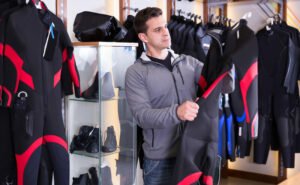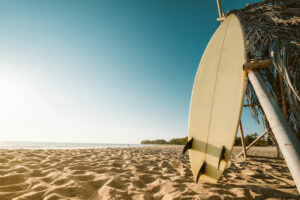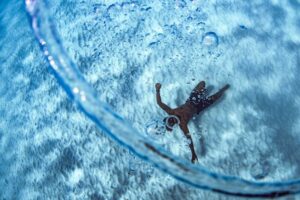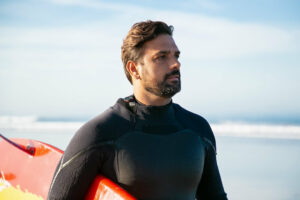Snorkeling is a fun activity the next time you plan your trip to the beach. It allows you to explore underwater life and take a glimpse at all the mesmerizing creatures that can be found here.
You might have already bought your first snorkel and are excited to try it out. But before you strap your snorkel around your head and jump into the sea, it is important to understand how snorkeling really works.
That is why today you will learn everything you need to know about snorkeling, so you will be fully prepared for your next trip to the deep blue sea.
In this article, you will get answers to the following questions:
- How does a diving snorkel work, and how do I use it correctly?
- What happens when I get water into my snorkel?
- What types of snorkels are there, and which one is the best for me?
The Basics of every Snorkel
Snorkels are fantastic inventions that let you breathe underwater without having to wear an oxygen mask. The idea behind snorkels is simple. That is why they can be traced back to Ancient Greece, where they have been already used to harvest sponges. Although snorkels nowadays come in different shapes and functions – wet, semi-dry and dry – the basics never change.
A typical snorkel always consists of:
- a mouthpiece
- the main tube
- and a mask clip
How does a Diving Snorkel work and how to use it
You are probably already excited to try out your snorkel. But before you head out to the sea and dive into the water, it is important to set up your snorkel and mask correctly.
Follow these 5 steps for the best snorkeling experience:
- Put on your diving mask and make sure it fits snugly and seals properly to help prevent fogging.
- Attach the snorkel to your mask using the snorkel keeper, mask clip, or other attachment and adjust it as needed for a comfortable fit.
- Place the mouthpiece in your mouth and bite it gently. Your lips should hold it in place and seal around it.
- Put your face in the water, make sure to keep the top of the tube above the waterline, and breathe in through your mouth.
- Once you feel comfortable, you can try swimming around while continuing to breathe deeply.
How to Breathe Underwater With a Snorkel?
Especially for beginners, it might be unusual breathing air through a tube while having your head underwater. All too often, beginners who are not yet familiar with breathing underwater start to get hectic and panic, which prevents the ultimate snorkeling experience.
So, to really understand how a diving snorkel works, one must also know how to breathe correctly when snorkeling.
Generally, snorkel tubes must adhere to a specific standardized length. The European standards set a limit for snorkel tubes at 38 cm. This maximum length is set to enable gas exchange and provide the diver with sufficient oxygen.
That is why you don’t see snorkels with huge tubes, as this would prevent the exhaled carbon dioxide to get out and fresh oxygen get into the lungs of the diver.
Beginners sometimes feel anxious at first, knowing they are limited to air that passes the snorkeling tube. Therefore, try to maintain a stable breathing rhythm by inhaling and exhaling at a slow and steady pace. This will help your body calm down, and you will see that there is no need to panic.
When breathing, take slow, deep breaths to conserve energy and ensure proper air exchange. Taking breaths that are not deep enough can make you feel dizzy after some time, due to a surplus of carbon dioxide.
Factors That Affect Snorkelers Time Underwater
1. Experience
The basics of snorkeling might be simple, but with every activity come factors that have can influence the experience. This is also the case when snorkeling. As a beginner, you will certainly have to get used to breathing through a tube underwater. But with time, you will learn to inhale and exhale efficiently for maximum gas exchange and increase your time underwater. So, experience is the first and foremost factor influencing the duration of your snorkeling session. Practice makes perfect!
2. Technique
It is common knowledge that to master any skill you not only need experience but also the right technique. And snorkeling is all about technique. You need to learn how to breathe correctly to lower your pulse, to act accordingly when water enters your snorkel, and to calmly float in the water rather than making aggressive movements.
3. Fitness
Next to experience and technique, your overall body fitness plays a role too. Are you an active person on land? Are you into endurance sports like running? Do you generally consider yourself a sporty person? Your fitness-level will definitely have a positive effect on your snorkeling duration. So, if you want to turn into a high-level snorkeler, you might want to start increasing your lung capacity on land first.
4. Water Temperature
Not only your skills in the water have an impact on the duration, but also the water itself makes a difference when snorkeling. In colder waters, your heart has to work harder to maintain your core body temperature, hence using up your energy quicker. As a result, you will feel fatigued quicker than in warmer waters, decreasing your time spent underwater.
What happens if Water enters my Snorkel?
Since snorkel tubes are rather short and only allow diving at the water’s surface, it is not unusual for snorkelers to get their mouths full of water.
In such a case, it is again important not to panic. When you notice water entering the snorkel, you can easily clear the tube by exhaling sharply and forcing out the water at the top of the tube.
Of course, you can always remove your mouthpiece from your mouth, allowing the remaining water in the tube to drain out.
When water enters your snorkel, it is wise to take a short break from diving to allow your pulse to lower again and your body to calm down. After a short break, you will feel ready to go for the next round.
Types of Snorkels and their Benefits
Snorkels can be put into three broad categories, with each having its unique benefits to it:
- Wet snorkel (classic)
- Semi-dry snorkel
- Dry snorkel
Wet Snorkel
- In its basic form, the wet snorkel consists of a mouthpiece and attached to it a J-shaped tube. Wet snorkels are often lighter, narrower, and shorter than semi-dry and dry snorkels and do not come with a purge valve that helps the diver with tube clearance when water enters the snorkel. Wet snorkels are therefore recommended for advanced snorkelers who prefer the lighter weight on their head or want to prepare for their next freediving course in Mexico.
Semi-Dry Snorkel
- Semi-dry snorkels stand midway between the classic wet snorkel and the dry snorkel. Next to the basic mouthpiece and tube, they are characterized by a splash guard, purge valve and flex tube. When designed correctly, splash guards help prevent chunks of water enter the top of the snorkel. If water still makes it into the snorkel, the purge valve helps you get it out again. The flex tube is a feature that allows you to adjust the mouthpiece and getting it into a comfortable position. Semi-dry snorkels are great for beginners and advanced snorkelers.
Dry Snorkel
- The benefits of a dry snorkel lies in its float valve at the top of the tube. The float valve is a mechanism that seals the snorkel if it gets submerged. Hence, the dry snorkel literally keeps the tube “dry” when diving too deep or getting hit by a big wave. This means dry snorkels rarely need to be cleared from water. Due to the nature of its function, the dry snorkel is a great option for beginners and people who have difficulties with water clearance.
Additional Snorkeling Equipment
Once you have made your first experiences underwater and know how a diving snorkel works, you might want to upgrade your snorkel-game by investing in some additional equipment. This includes:
- Fins
- Snorkel vest
- Wetsuit
These extras will allow you to get the very best out of your snorkeling-experience. Fins will make you more efficient while swimming, the snorkel vest will help keep you effortlessly afloat in the water, and the wetsuit will give you the necessary thermal protection when exploring colder terrains.
Conclusion: Everybody can snorkel!
Snorkels are a great tool to explore the deep blue sea with all its fascinating life. They come in three broad styles, all having different features and benefits to them.
For beginners, semi-dry or dry snorkels are the best option, as they help prevent water from entering the snorkel tube through mechanisms like the splash guard in semi-dry snorkels or the float valve in dry snorkels.
Due to their lighter weight, advanced snorkelers tend to prefer the classic wet snorkel, which solely consists of a mouthpiece and the snorkel tube. Snorkeling is a fun activity for people of all ages and to make the best out of it, always remember: keep calm and continue breathing.
FAQ to how does a snorkel work
There are different types of snorkels – wet, semi-dry and dry – but not each snorkel type helps you keep water out. As the name already suggests, the benefits of a dry snorkel lies in its ability to keep the snorkel dry. Dry snorkels are equipped with a float valve at the top of the tube. The float valve is a mechanism that seals the snorkel if it gets submerged. This also means dry snorkels rarely need to be cleared from water, which makes them an ideal option for beginners or people who have difficulties with water clearance.
Even though dry snorkels help prevent water enter the snorkel, this does not mean that they also allow you to breathe underwater. In order to breathe through the snorkel, the tube must always be above the water to allow gas exchange. If you want to go beyond the waters’ surface, you might want to try out scuba diving.
It may not seem logical, but believe it or not, you are able to go fully underwater with a snorkel. In order to do so, you need to take a deep breath above the water and hold that breath. Now you can go underwater with your snorkel. But caution: this does not mean that you can also use the snorkel to breathe underwater!
How long you can stay underwater hugely depends on your snorkeling experience. Beginners should start off with short 1-2 minute sessions to get used to breathing underwater. But also, for experienced snorkelers, it is not recommended to dive for more than 2 minutes.
Here are 5 quick snorkeling tips if you are just starting out:
1. Make sure to find the perfect fit for your mask. Snorkeling should be a fun activity, and a well- fitted mask will help you have a great experience.
2. In case your mask is foggy, you can simply defog it by applying baby shampoo or defogging gel. A quick and easy fix for the best vision underwater.
3. For an even greater snorkeling experience, get a pair of full-foot fins to preserve energy underwater.
4. Get excess water out of your mask when needed and when choosing a snorkel, go for a semi-dry or dry snorkel to prevent water from entering the snorkel.
5. Snorkeling is all about breathing. Take deep focused breaths to help yourself relax.









